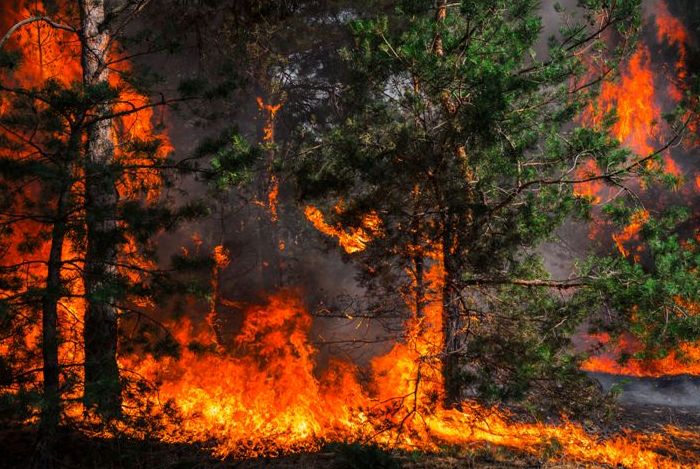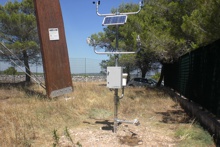Forest fire alarm
Main applications
1. Monitoring and prevention of forest and forest fires
2. Multi-point environmental monitoring
More information
| Photo Gallery | Info / Quote request |
Description
MAIN FEATURES
In the monitoring network the functional elements are:
1. A series of wireless multi-parameter sensors mod. B-Sentinel located at strategic points in the wooded area to alert the on-call personnel and the operations centre in real time
2. A server with web software for monitoring the network and collecting and processing data
3. One or more web cameras to verify the presence of smoke/fire in the wooded area
4. A weather station mod. MicroMET for measuring environmental conditions
5. A communication system on a 2G-4G cellular network with data sending to an FTP area and alarms via SMS
The operating logic of the individual functional elements of the network listed above is described below.
Layout of the forest fire monitoring and warning system

1. Woking logic of B-Sentinel smart sensors
B-Sentinel has an operating logic managed by a microprocessor that allows you to configure both the data storage and transmission rate and the alarm thresholds of all connected measurements.
Each individual B-Sentinel independently acquires the instantaneous data of the connected sensors and verifies that the CO2 value is lower than the set threshold value (the value is always checked every 5 minutes to allow the CO2 sensor to preheat):
- If the value is below the threshold, B-Sentinel remains silent and stores the data without activating the alarm. In this mode, B-Sentinel periodically sends a simple confirmation of its functionality to the server.
- If the value is above the set threshold, the system activates by sending two alarm SMS to two available people and at the same time begins to transfer the new information to the dedicated web server
2. Operating logic of the server with web service
The server with web service will receive data from all B-Sentinels connected in GPRS mode and will display the following information on correct operation on synoptic windows:
- Date/time of last data transmission
- Battery voltage (diagnostic data)
- Air temperature value
- Air humidity value
- Measured CO2 value
Windows will be represented in the dedicated web area that will contain multiple B-Sentinels; the wooded area must be divided into zones, so that each individual B-Sentinel is able to cover a specific wooded area.
Multiple B-Sentinels and a Web Camera (FC-Web) can be associated with each zone window, which can transfer images of the controlled area. In alarm mode, the server will manage the alert sending package via e-mail. The server can also deactivate/modify one or more B-Sentinel units, as well as manually request images from a camera for any alarm checks or validations.
3. Operating logic of web cameras (FC-Web) in alarm mode
When one of the B-Sentinels detects that the CO2 threshold has been exceeded, it goes into alarm mode and transmits the alarm data to the server, which activates to send an e-mail to the registered people with the information relating to the threshold being exceeded in each area (10 e-mails x 10 people maximum).
The Server commands the FC-Web, relating to the area where the alarm started, to switch to fast acquisition mode; in this way the camera sends a series of photos every 5/10 minutes for a maximum time of 60 minutes.
From the server, with a manual request button, it is possible to have an impromptu photo sent even when the system is not in alarm mode. In this way, it is possible to carry out checks on the forest status or perform a functional diagnostic of the system.
The acquired photos can be managed as follows:
- Option 1): The photos remain available for a maximum of 24 hours
- Option 2): The photo is replaced by the new one without the possibility of image archiving
4. Operating logic of the meteorological station
The meteorological station is mainly used to evaluate the environmental favourable conditions that can develop the fire in the forest area; it is also used, during the occurrence of the event, to evaluate the wind conditions to support the personnel in charge of extinguishing. For this purpose, the station is equipped with the following measurement sensors:
- Wind speed and direction
- Air temperature and humidity
- Atmospheric pressure
- Precipitation
- Global solar radiation
- Temperature and humidity of the ponderosa pine stem (optional)
Each measurement is used to evaluate in real time the climatic conditions of the site and establish the degree of danger of possible development of the fire.
5. Operating logic of the data transmission system
The data transmission system is based on a GPRS wireless network that allows the transfer of data to a protected FTP area, while for sending alarms it uses SMS message technology. This system allows to obtain a wireless network in telemetry with distributed intelligence in which each Butterfly sensor and each weather station can transmit data autonomously without the need to rely on intermediate repeater points for retransmission.









